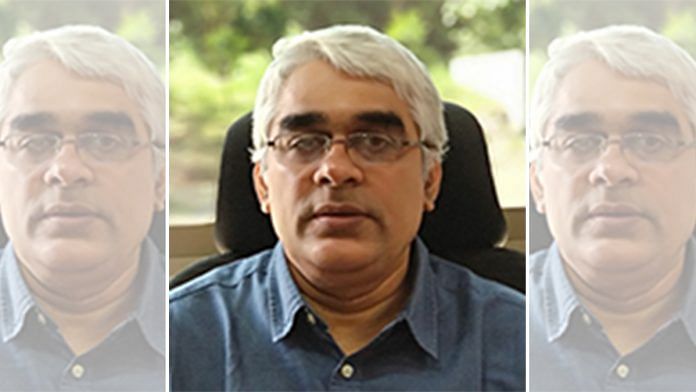New Delhi: India must improve its early warning systems in preparation for more frequent extreme weather events, apart from reducing emissions “as much as possible”, said a coordinating lead author of the Intergovernmental Panel on Climate Change (IPCC)’s damning report released earlier this month.
Speaking to ThePrint in an interview, R. Krishnan, a coordinating lead author of the water cycles chapter in the report, said India has made large strides in improving its weather prediction forecasts, as well as in its preparation for extreme weather events, but “we need to scale it up”.
“More and more of these extreme precipitation events are about to come,” he said, referring to floods, droughts and heavy precipitation due to tropical cyclones.
“This problem is going to get further amplified, and this is where I think a lot of focus is needed. We need to further enhance the coordination among weather and climate forecasters, hydrologists, water managers, agriculturists, disaster management, rescue teams and civil society at large to handle these types of situations,” said Krishnan, who is the executive director of the Centre for Climate Change Research at the Indian Institute of Tropical Meteorology.
The IPCC report used Krishnan’s climate change model, called the Earth System Model, to predict the effect of global warming on the South Asian region, which includes India. It is the first climate model from the region to be included in an IPCC report.
“Heatwaves and humid heat stress will be more intense and frequent during the 21st century,” the IPCC Sixth Assessment Report (AR6) released 9 August said, adding that “both annual and summer monsoon precipitation will increase during the 21st century”.
Also read: We will see more storms and floods — IPCC report shows water cycle intensifying
Why rising temperatures will cause more rain
In the short term, predicting the effect of human-induced climate change is more difficult because of uncertainties caused by spontaneous and natural climate events, which can cause changes in the atmosphere, Krishnan said.
But in the mid-term and long-term, India will see heavier rainfall because climate change will be “dominated” by the effects of global warming.
The IPCC report noted that since pre-industrial levels, the amount of carbon dioxide in one million litres of air has increased from 280 parts per million to 419 parts per million. Temperatures have already risen 1.1 degrees above pre-industrial levels, and the report warns that a breach of 1.5 degrees — which can cause further irreversible climate change — is imminent in the next 20 years.
“A property of carbon dioxide is to trap the radiation that is emitted by the planet. If you’re continuously adding carbon dioxide to the air, it’s going to cause the atmosphere to warm up,” Krishnan explained, adding that for every degree rise in temperature, water vapour in the air increases by 7 per cent.
“The issue is water vapour itself is a greenhouse gas, and that will also trap the radiation, which will amplify the warming,” he said.
Developing a climate model
Accounting for climate change includes much more than just weather forecasting, Krishnan said, because it tracks the interactions of the atmosphere, ocean, cryosphere (frozen parts of the ocean) and biosphere, while predicting the effects of rising carbon dioxide levels and aerosols — suspensions of solid or liquid particles in air — over several years.
A major challenge is creating a radiation balance system, which measures the inflow and outflow of energy in the atmosphere.
“Typically we run the model for 500 to 600 years and the model should come to an equilibrium, because we were not adding any extra energy through greenhouse gasses. There should be no loss or gain of heat, and mean temperatures should stabilise, that is very important,” Krishnan said.
He added that it took over four years for him and his team to develop a radiatively balanced climate model for long-term climate studies. A working model was finally developed in 2017.
“We learned how to vary the greenhouse gases in the model, how to add the aerosols in the model, how to incorporate the land use and land cover changes. We built the human capacity in our centre. This has taken place through several stages,” he said.
Also read: Surviving the next 50 years is an existential crisis – 3 things we must do now
India and emissions
The IPCC report said the world must work towards “limiting cumulative CO2 emissions, reaching at least net zero CO2 emissions, along with strong reductions in other greenhouse gas emissions”.
“Strong, rapid and sustained reductions in CH4 emissions would also limit the warming effect resulting from declining aerosol pollution and would improve air quality,” it added.
India, which has resisted cutting emissions to zero, has historically maintained that the responsibility of making deep cuts in emissions lies with developed countries.
While India is the third-largest emitter of carbon dioxide, its per capita emissions are at a mere 1.8 metric tonnes, compared to a country like the US, which is at 15.24 metric tonnes per capita.
India’s first reaction to the IPCC report was to reiterate this stand, one that Krishnan agrees with.
“If you see the countries that are contributing, it’s mostly coming from the developed countries, and India’s per capita contribution is very, very small,” he said. “Of course, India has also agreed to do its bit to reduce emissions, and there are already efforts in promoting renewable energies and solar energies. But definitely, the big cut has to come from those countries.”
In the 2015 Paris Agreement, India agreed to reduce greenhouse gas emissions by 33 to 35 per cent of their 2005 intensity of GDP by 2030.
Also read: At UN climate meet, alliance co-founded by India hopes to realise dream of a global solar grid






